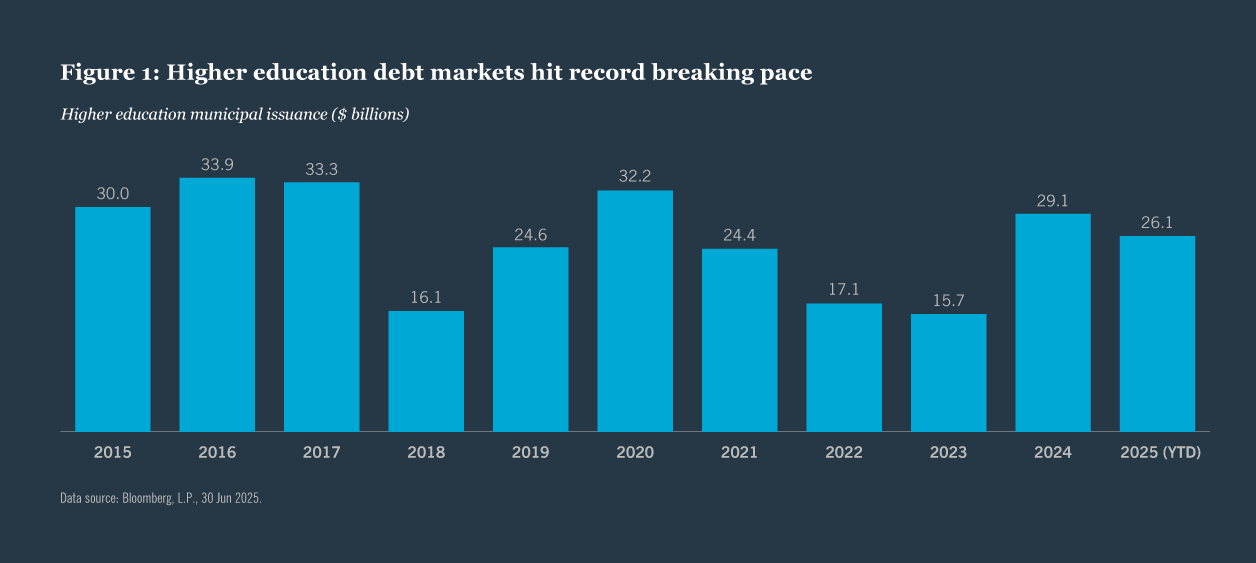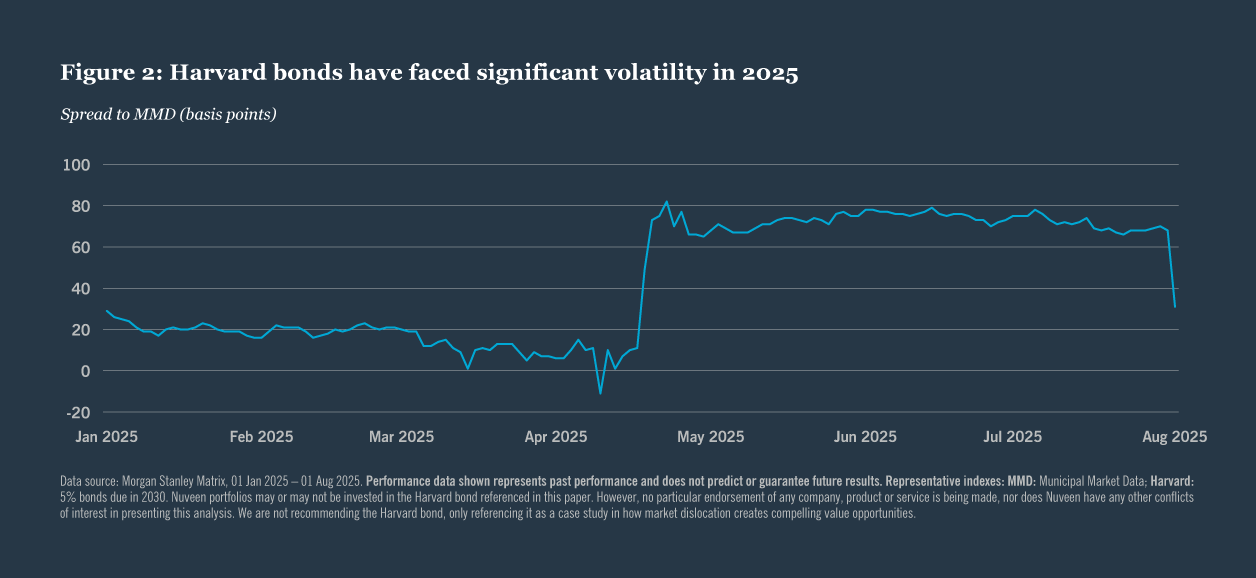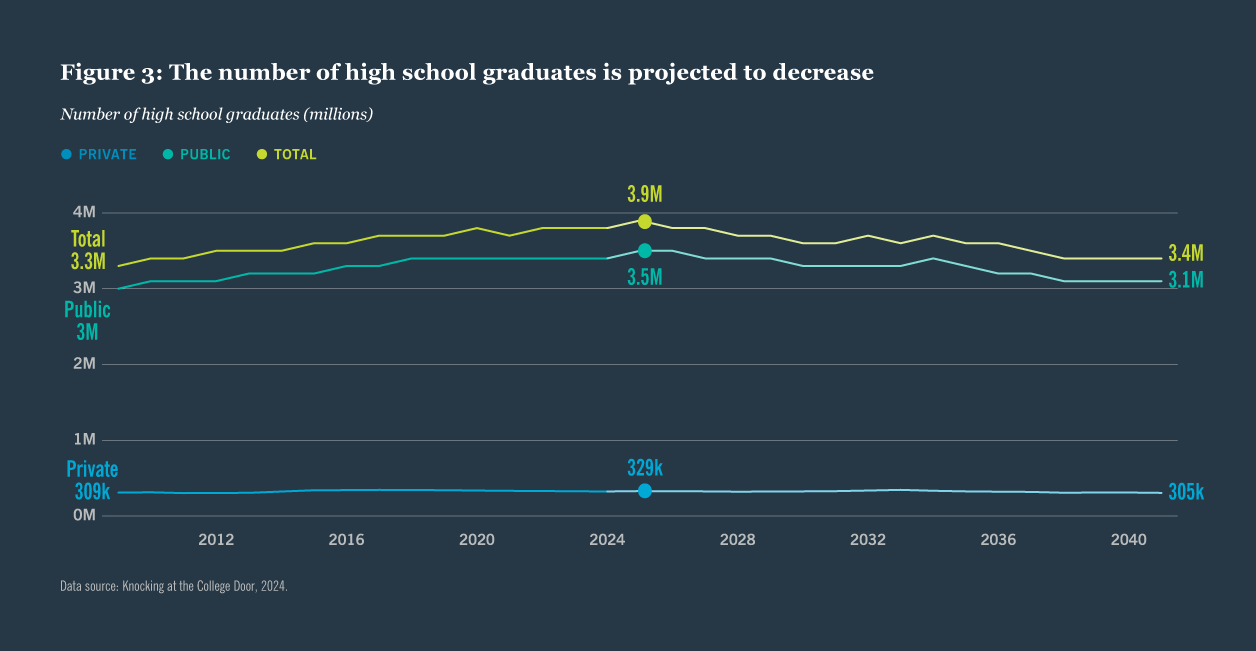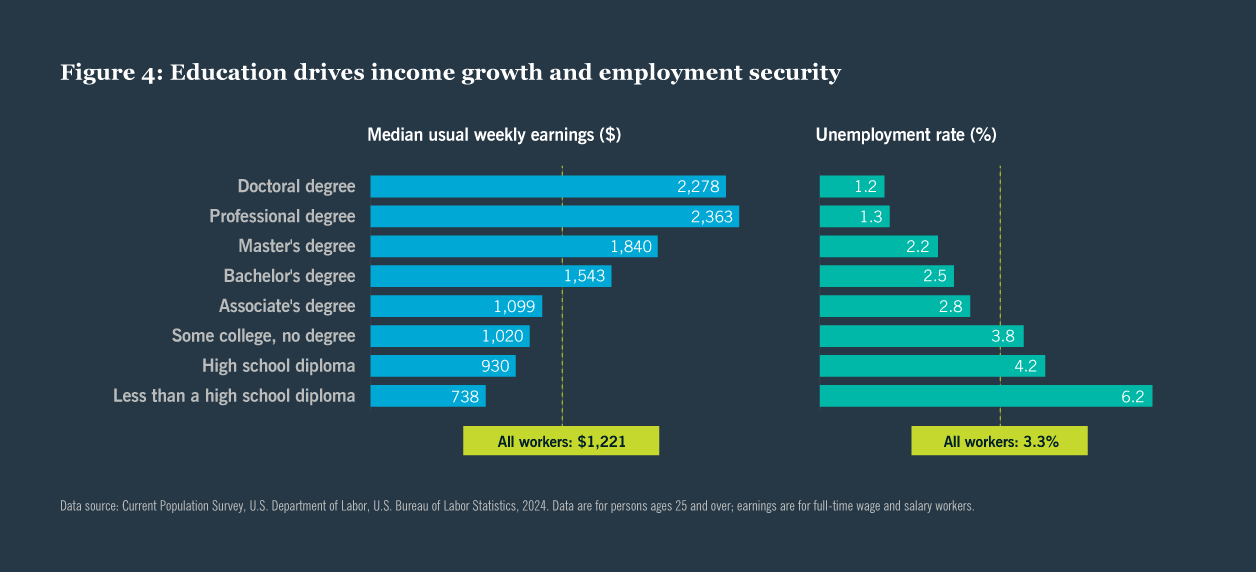
TOOLS
Login to access your documents and resources.
Listen to this insight
~ 25 minutes long
Higher education institutions face unprecedented challenges from demographic shifts, federal scrutiny and infrastructure needs. Municipal bonds provide essential financing that enables these institutions to build state-of-the-art facilities, maintain competitive campuses and secure operational liquidity. For investors, higher education bonds offer attractive opportunities within the municipal market, particularly as recent market dislocations have created compelling value propositions in a sector with significant long-term capital requirements and societal importance.
By the numbers
- 3,200: approximate number of U.S. nonprofit higher education institutions.1
- $262 billion: higher education bonds outstanding; $26 billion issued in 1H25, up 37% compared to last year.2
- 52%: top ten higher education borrowers account for the majority of 2025 new bond issuance.3
- $950 billion: capital investment needed to address deferred maintenance backlog for higher education issuers.4
- 171%: increase in applications via the Common Application from 2014 to 2024.5
Muni bonds finance higher education’s infrastructure Renaissance
Consider these high impact infrastructure projects financed by municipal bonds: The Big House, home to University of Michigan football and the largest stadium in the United States; Carnegie Mellon University’s 278,000 square foot Richard King Mellon Hall of Sciences; and the University of Rochester’s nationally recognized Wilmot Cancer Center.
Municipal bonds are essential for higher education because they provide a critical source of cost effective, long-term financing for public and private nonprofit colleges and universities. Bond proceeds are used to build and renovate dormitories, classrooms, libraries, laboratories and athletic facilities and meet other infrastructure needs.
Unlike in many other parts of the world, where most college students are commuters, students in the U.S. seek an immersive college experience, where they learn, live, eat and socialize. As such, institutions find themselves competing to attract students with high quality facilities, leading to an arms race in capital infrastructure and increased reliance on the municipal market for financing needs.
By tapping the municipal market for capital, institutions can preserve their own cash and investments for other uses such as scholarships, faculty salaries and research. Additionally, access to stable and predictable financing allows institutions to engage in long-term planning for the betterment of their students, staff, alumni and communities.
In addition to capital investment, institutions also occasionally borrow to fund operations. For example, many highly rated institutions — such as Harvard (rated AAA by Standard & Poor’s), Columbia (AAA), MIT (AAA), Yale (AAA) and Princeton (AAA) — recently issued taxable municipal debt to bolster balance sheet liquidity in the face of potential reductions in federal funding.
Access to low-cost borrowing enables institutions to keep campuses updated and provides liquidity to fund educational and research priorities.
Higher education bond issuance surges amid policy uncertainties
Higher education debt constitutes a significant portion of the municipal bond market, representing approximately 6% with $262 billion outstanding of the $4.3 trillion total market. The sector has experienced remarkable growth in 2025, with issuance both accelerating in pace and expanding in volume. In the first half of 2025, higher education borrowers issued $26 billion in municipal bonds — a 37% increase compared to the same period last year, substantially outpacing the broader municipal market’s 14% growth (Figure 1).
To put this surge in perspective, the sector’s issuance in just the first six months of 2025 nearly matched the entire $29 billion issued throughout 2024. While 115 institutions have accessed the debt markets this year, issuance remains concentrated, with the top ten borrowers accounting for over half of the total volume.
Accelerated issuance in early 2025 primarily stemmed from uncertainties regarding federal research grants, endowment taxes, student aid and international student policies. These concerns motivated institutions to secure financing before potential adverse policy decisions could affect their operations. Several prestigious universities — Harvard, Princeton, MIT, Brown, Stanford and Yale — exemplify this trend, collectively issuing $2.8 billion in taxable debt during the first half of 2025 to bolster liquidity against possible federal funding reductions.
Nuveen anticipates issuance patterns will normalize as federal policies gain clarity. Nevertheless, the sector should maintain steady issuance momentum as institutions continue addressing capital requirements through municipal markets regardless of federal policy outcomes. The magnitude of this ongoing need is substantial — Moody’s projects that addressing the sector’s deferred maintenance backlog could require up to $950 billion in capital investment over the next decade.
Blue Turf Stadium renovation: Boise State University
Boise State University’s Albertsons Stadium, renowned for its distinctive Blue Turf, stands as an iconic collegiate sports venue. First installed in 1986 and federally trademarked in 2011, the Blue Turf has become synonymous with the Broncos’ formidable home-field advantage, evidenced by their perfect 7–0 record during the 2024–2025 football season. Originally constructed in 1970 with seating capacity exceeding 36,000, the stadium entered a new chapter in February 2025 when the university issued $48 million in municipal bonds to fund comprehensive renovations.
These bond proceeds will fund a comprehensive stadium renovation project that includes constructing a continuous concourse around the venue and adding 1,600 premium/field-level seats. All improvements are scheduled for completion before the 2026 football season kicks off. Investors in these municipal bonds will receive payments from a diversified revenue stream that includes tuition, housing fees, event ticket sales and ancillary income sources such as parking fees.
Beyond enhancing the experience for athletes, fans and students, this renovation project generates significant economic benefits. With ticket sales alone generating $8 million in 2024, the expanded facility will continue to boost Idaho’s economy while strengthening the state’s cultural identity and athletic reputation.
Market dislocation creates compelling value opportunities
Nuveen continues to identify compelling investment opportunities within the higher education sector. Record-setting issuance has created favorable pricing conditions for buyers in the new issue market. With the One Big Beautiful Bill Act now finalized and policy implications clarified, we expect issuance patterns to normalize, potentially driving stronger performance through the second half of the year.
As students head back to campus this fall, investors are closely watching enrollment figures to assess both incoming freshman demand and retention rates of prior years’ students. These metrics will help the market gauge the full impact of recent federal policy shifts affecting student loan eligibility and international student visa requirements.
Recent heightened federal scrutiny has widened credit spreads beyond historical averages — approaching levels typically associated with riskier sectors — even for highly rated institutions like Harvard and Columbia. This presents potential value opportunities for discerning investors.
Harvard’s bonds have experienced significant volatility this year amid ongoing tensions with the Trump administration (Figure 2). The 5% bonds due in 2030 saw their spread widen dramatically from 29 basis points (bps) in January to 82 bps in late April, when the administration threatened to revoke the university’s tax-exempt status.
While moderating slightly to 70 basis points by 30 June, spreads briefly narrowed on 01 August following rumors of a potential settlement. Despite the recent tightening, the Nuveen research team identified the approximately 50 bps widening as a potential buying opportunity, particularly notable for a AAA-rated institution with a $53 billion endowment.
The sector’s demographic challenges and affordability concerns are longstanding issues. Institutions with strong management teams and greater financial flexibility that have proactively addressed these challenges stand better positioned to navigate new federal and regulatory changes, making them particularly attractive investment candidates.
Navigating complexity in higher education bond analysis
As many parents and high school students can attest, gaining college admission today often seems extraordinarily challenging. Meanwhile, headlines regularly feature increased federal government scrutiny of higher education institutions. Against this complex backdrop, investors might reasonably question whether higher education bonds represent a prudent investment opportunity.
As bond investors, our responsibility extends beyond headlines to conduct thorough evaluations of colleges and universities based on fundamental metrics including student demand, financial position and management quality. We approach this analysis through the following framework:
Student demographic shifts challenge demand
Following the digitization of the Common Application, first year applications to member institutions increased 171% between fall 2014 and fall 2024, intensifying competition across institutions. The University of Texas exemplifies this trend, having broken its application record for three consecutive years with over 90,000 applications for fall 2025 — a 25% increase from the previous year. Many prestigious institutions have experienced similar application surges, resulting in declining acceptance rates.
However, these highly competitive schools represent only a small segment of America’s approximately 3,200 non-profit higher education institutions, all competing for a diminishing pool of high school graduates. As birth rates have declined, the number of high school graduates is projected to peak at 3.9 million in 2025 before decreasing by an estimated 13% through 2041 to 3.4 million — a phenomenon widely described as the demographic cliff (Figure 3).
Institutions that successfully attract and retain students from this shrinking applicant pool will maintain stronger financial positions moving forward. This demographic reality has already impacted many colleges and universities over the past decade, with declining freshman classes and overall enrollment. The pandemic exacerbated this trend, causing sector-wide enrollment to drop by 5% before returning to pre-pandemic levels in fall 2024.
Smaller colleges face particular vulnerability to these enrollment shifts, as even modest declines significantly impact their tuition revenues. In contrast, larger institutions with diverse student populations can often offset undergraduate enrollment decreases by expanding graduate programs or attracting nontraditional students.
Financial fundamentals drive sustainability and creditworthiness
Beyond demand and enrollment metrics, an institution’s fiscal health plays a crucial role in determining its sustainability and debt repayment capacity. Operating margin — calculated as the excess of revenues over expenses — provides insight into an institution’s financial cushion and flexibility to manage revenue and expense pressures, whether from enrollment-driven tuition declines or inflationary cost increases. Strong operating margins generate additional cash flow for debt service, enhancing creditworthiness.
Liquidity represents another vital measure of fiscal strength, typically assessed through metrics such as Days Cash on Hand and available resources to debt ratios. These indicators quantify an institution’s capacity to fund both operations and long-term debt obligations. Complementing operating cash, endowments serve as significant sources of liquidity and flexibility for higher education institutions. These permanent investment pools, funded through gifts, allow universities to draw annual percentages to support operations, scholarships and faculty positions.
However, endowment values vary dramatically across institutions. According to the National Association of College and University Business Officers (NACUBO) 2024 endowment study, only 150 of 669 participating institutions have endowments of more than $1 billion, which accounts for about 90% of the total endowment value of all post-secondary institutions. This disparity has created pronounced stratification between institutional haves and have-nots. Colleges with larger endowments enjoy greater flexibility to attract premier students and faculty while weathering sector headwinds, such as potential reductions in federal funding for grants and student loans.
Leadership stability and strategic vision drive success
Finally, we evaluate management and governance in how effectively they run the institutions. With significant leadership turnover recently across the sector, the depth and breadth of the management team and favorable relationship with the board are critical to maintaining stability. Long term planning and risk management enable an institution to better adjust to shifting revenue and expense pressures.
Bond security provisions scale with institutional credit quality
Security provisions for bonds issued by colleges and universities vary significantly based on creditworthiness. Higher rated institutions typically offer investors a general obligation pledge — a straightforward commitment to repay debt from all available resources without specific collateral.
For institutions lower in the credit spectrum, enhanced security provisions protect investor interests. Rate covenants establish minimum net revenue thresholds required for debt service coverage. Should revenues fall below these thresholds, investors typically have the right to engage consultants to evaluate the institution’s fiscal condition and recommend improvements.
Additional protective measures include debt service reserve funds — restricted pools of cash and investments available for debt service payments when institutional revenues prove insufficient. “Additional bond tests” prevent overleverage by limiting future borrowing based on net revenue calculations.
The lowest-rated institutions may provide tangible collateral such as campus mortgages, allowing investors to foreclose and liquidate properties to recover their investments in default scenarios.
Higher education enables social and economic mobility
Higher education has profoundly shaped the United States at both individual and societal levels. Access to education — regardless of race or economic background — has served as a critical pathway to social mobility and achievement of the American Dream, equipping individuals with essential skills for productive participation in society.
Both associate’s and bachelor’s degree programs provide specialized capabilities necessary to compete in today’s rapidly evolving labor market. By enhancing employability, higher education creates pathways to greater financial security and overall economic well-being. Research consistently demonstrates that individuals with advanced education, particularly bachelor’s degrees and beyond, enjoy substantially better financial outcomes. Bureau of Labor Statistics data reveals that bachelor’s degree holders experience unemployment rates less than half of those of high school dropouts, while earning more than twice the income on average (Figure 4).
Resilient institutions should emerge stronger through adaptation
Higher education has transformed countless lives worldwide, with municipal financing playing a crucial role in helping institutions fulfill their educational missions.
Despite the sector’s current challenges, institutions demonstrating strong demand, robust financial management and visionary leadership remain well-positioned to serve future generations while delivering stable, long-term value to investors. The changing landscape offers a valuable opportunity for higher education institutions to reassess their business models and implement efficiencies that better address affordability concerns and restore public confidence in higher education.
Investors are particularly focused on how institutions respond to these challenges through strategic initiatives like eliminating undersubscribed academic programs, forming partnerships to enhance programs and share costs and implementing innovative uses of campus real estate. Those institutions capable of successfully navigating the evolving policy environment will ultimately emerge stronger and more resilient.
Related articles
High yields, valuations and credit fundamentals are driving investor recognition that municipals have turned the corner.
The impact of shifting tariff policies on municipal credit will vary greatly by sector and region.
The rise of artificial intelligence has driven growth in U.S. data centers, creating economic opportunities for municipalities issuing bonds.

Endnotes
Sources
1Data source: National Center for Education Statistics; Digest of Education Statistics, through academic year 2022–23.
2Data source: Bloomberg, L.P., 01 Jan 2025 – 02 Jul 2025.
3Data source: Janney Higher Education and Not-for-profit Financial Advisory Group.
4Data source: Moody’s Ratings, Pent-up capital needs: The hidden liability with a hefty price tag, 20 Aug 2024.
5Data source: Common App, End-of-season report, 2014-2024: first year application trends, 22 Aug 2024.
Bureau of Labor Statistics, https://www.bls.gov/emp/chart-unemployment-earnings-education.htm
Boise State University Preliminary Official Statement, https://emma.msrb.org/P11826177-P11399511-P11840741.pdf
Boise State University ticket sales, https://knightnewhousedata.org/fbs/mwc/boise-state-university
Bloomberg
Janney Higher Education & Not-for-profit Financial Advisory Group
Moody’s, https://ma.moodys.com/rs/961-KCJ-308/images/Sector_In-Depth-Higher-Education-US-Pentup.pdf?version=0
https://nces.ed.gov/programs/digest/d23/tables/dt23_317.10.asp
University of Texas Fall 2025 applications, https://news.utexas.edu/2024/12/06/demand-soars-as-ut-shatters-record-for-freshman-applications/
NACUBO-Common fund Study of Endowments, https://www.nacubo.org/Research/2024/Public-NCSE-Tables
Knocking at the college door, https://www.wiche.edu/knocking/resource-library/
Enrollment estimates, https://www.wiche.edu/knocking/resource-library/
The views and opinions expressed are for informational and educational purposes only as of the date of production/writing and may change without notice at any time based on numerous factors, such as market or other conditions, legal and regulatory developments, additional risks and uncertainties and may not come to pass. This material may contain “forward-looking” information that is not purely historical in nature. Such information may include, among other things, projections, forecasts, estimates of market returns, and proposed or expected portfolio composition. Any changes to assumptions that may have been made in preparing this material could have a material impact on the information presented herein by way of example. Performance data shown represents past performance and does not predict or guarantee future results. Investing involves risk; principal loss is possible.
All information has been obtained from sources believed to be reliable, but its accuracy is not guaranteed. There is no representation or warranty as to the current accuracy, reliability or completeness of, nor liability for, decisions based on such information and it should not be relied on as such. For term definitions and index descriptions, please access the glossary on nuveen.com. Please note, it is not possible to invest directly in an index.
Important information on risk
Investing involves risk; principal loss is possible. All investments carry a certain degree of risk and there is no assurance that an investment will provide positive performance over any period of time. Investing in municipal bonds involves risks such as interest rate risk, credit risk and market risk. The value of the portfolio will fluctuate based on the value of the underlying securities. There are special risks associated with investments in high yield bonds, hedging activities and the potential use of leverage. Portfolios that include lower rated municipal bonds, commonly referred to as “high yield” or “junk” bonds, which are considered to be speculative, the credit and investment risk is heightened for the portfolio. Bond insurance guarantees only the payment of principal and interest on the bond when due, and not the value of the bonds themselves, which will fluctuate with the bond market and the financial success of the issuer and the insurer. No representation is made as to an insurer’s ability to meet their commitments. This information should not replace an investor’s consultation with a financial professional regarding their tax situation. Nuveen is not a tax advisor. Investors should contact a tax professional regarding the appropriateness of tax-exempt investments in their portfolio. If sold prior to maturity, municipal securities are subject to gain/losses based on the level of interest rates, market conditions and the credit quality of the issuer. Income may be subject to the alternative minimum tax (AMT) and/or state and local taxes, based on the state of residence. Income from municipal bonds held by a portfolio could be declared taxable because of unfavorable changes in tax laws, adverse interpretations by the Internal Revenue Service or state tax authorities, or noncompliant conduct of a bond issuer. It is important to review your investment objectives, risk tolerance and liquidity needs before choosing an investment style or manager.
Nuveen, LLC provides investment solutions through its investment specialists.
This information does not constitute investment research as defined under MiFID.









